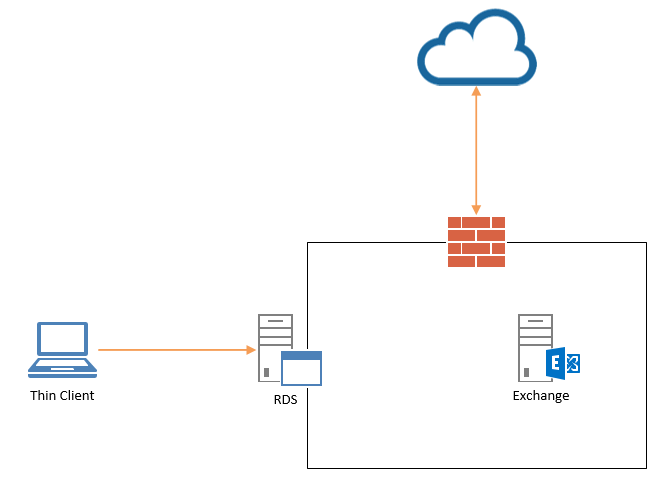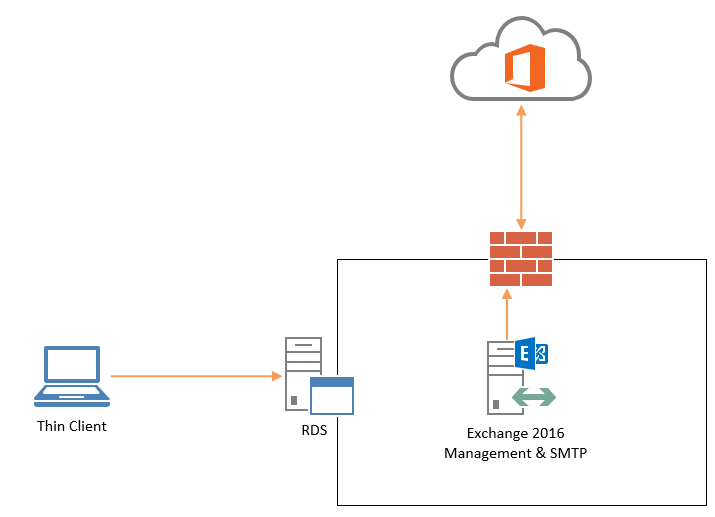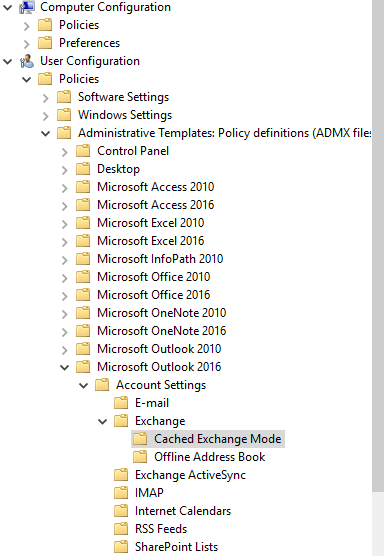What do to with Exchange in an RDS or Citrix environment
A lot of companies are working with thin clients that connect to an RDS-environment or a Citrix XenApp / XenDesktop environment.
On these remote connections, the employees want their email to function as it would on a normal client.
There are a lot of differences between Outlook-versions and Exchange-versions. This makes some migrations and setups even more challenging.
Allow me to explain the different approaches we do with Exchange on-premise and Exchange online.
Exchange On-Premise
The way we work with Exchange On-Premise is pretty straight forward: Do not cache!
Caching your mailbox with Exchange On-premise on the remote environment has zero to no advantages.
The server is located on the same LAN-network as the RDS-environment is. The RDS makes no external connections thus does not cause any performance issues.

RDS – Exchange On-Premise
Another reason why we do not work with caching in this case, is because the ost-files take unnecessary storage. If your remote environment is not scaled for this then the disk will fill up with ost-files. In Outlook 2013 and 2016, we can compensate this behaviour by lowering the cached period to e.g. 3 months. In Older Outlook-versions, it’s either download everything or download nothing.
Some users might take +10 GB on their own by just enabling cached mode.
Exchange Online
Exchange online is a whole different thing. Since all our mailboxes are located in the cloud, all connections through Outlook go to the external network.
This means that working in online mode will decrease your performance drastically. Unless you have a perfect, low-latency connection to Office365, it takes up to 4 seconds to only open an email.

RDS – Exchange online
This also means that we need to work with cached mode in our Outlook. But how are we going to handle this?
We handle this with applying some Office-specific Group Policies to the remote environment.
Note: This requires you to have Outlook 2016.
First, create a fileshare on a server where you want the ost-files to be stored on. give everyone write-access on the share.
download and install the Office 2016 / Office 2019 Administrative Template files to enable the Group Policies in your Active Directory environment.
When installed, open the Group Policy Editor and create a new policy. Edit the policy and go to User configuration > Policies > Administrative Templates > Microsoft Outlook 2016 > Account Settings > Exchange > Cached Exchange Mode

RDS 1
Change the following settings:
- Cached Exchange Mode: Enabled to Download All Items.
- Cached Exchange Mode Sync Settings: Enabled for a period of 3 months
- Disable Exchange Fast Access: Disabled
- Use Cached Exchange Mode for new and existing Outlook Profiles: Enabled
- Default location for OST files: The UNC-path of the fileshare you created earlier
- Disable shared mail folder caching: Disabled
Also enable GPO Loopback on the policy. This needs to be setup as “merge”.
Users who did not have cached mode enabled already, are enabled automatically when the GPO is pushed to the users and when they log back in.
Users who already have cached mode enabled need their email profile to be removed and recreated. This will put the OST-file to the right location.

I’m a 27 year-old Belgian working for Orbid NV as Senior System Engineer. I’m a member of the cloud Team where I focus on everything from Teams PSTN and Exchange to AVD & Intune.


This article is helpful, but the last 2 settings don’t seem to be in the available options. Is there another place where i can set the destination for the OST?
Hi Ben
I’m glad the article helped you out!
You can find the default location for OST files in the same GPO: Microsoft Outlook –> Miscellaneous-> PST Settings.
The option for the Shared Mailbox caching can be found in Microsoft Outlook -> Outlook Options -> Delegates.
Hope this helps you out.
Nice